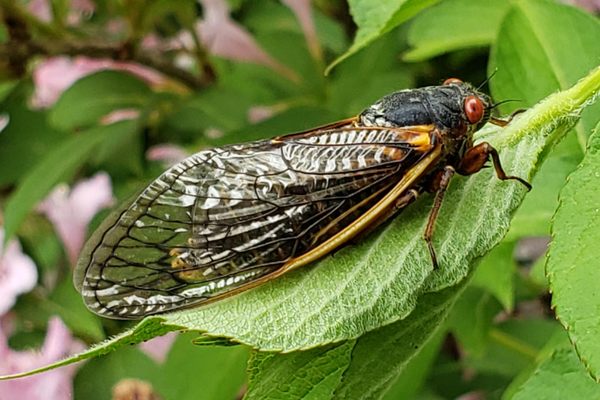
A Field Guide to the Miniature Menagerie Inside Your Own Home
And on your face.
In the early days of the pandemic, I hardly ventured out. I had gotten to know each paint-and-plaster corner of my apartment and the strip of sidewalk I can see from the window. I was well-versed in the shrieks and hisses of the pipes on cold nights; the chirps that drift in through the screen; the local dogs and their preferred places to squat. After five weeks of going nowhere, I was smug in my certainty that I had mapped nearly every inch of that place. But it turns out that there was a lot I was missing: I knew the terrain, but not my fellow citizens. Even though I wa the only human around, I had a lot of company—a whole host of arthropods and other tiny creatures that shared my home. So I asked entomologists how to get to know them better.
No matter where you live, your home is probably teeming with skittering, winged, or multi-legged life. In 2012, with the help of the North Carolina Museum of Natural Sciences, Rob Dunn, an ecologist at North Carolina State University, conducted a census of the arthropods in 50 homes in Raleigh. The team inventoried more than 10,000 critters spanning several hundred species. A few years later, Dunn and collaborators launched a similar project on iNaturalist, the digital citizen science platform, inviting people to report any sightings of non-domesticated creatures in their homes. That project, called Never Home Alone: The Wild Life of Homes, is now global in scope, and as of April 2020 has amassed more than 10,500 observations across more than 2,100 species.
Ecologists didn’t always take an interest in domestic spaces. For centuries, scientists prized pristine landscapes such as the Galápagos Islands. The idea, Dunn says, was that “if we study nature, we should study it where its rules are intact and undisturbed.” When Dunn undertook graduate work more than 15 years ago, he traveled to the Bolivian Amazon to study insects as a proxy for forest health and regrowth. At the time, he says, many scientists in the field believed that the city was “a muddier version of the world.” A house would have been seen as even less worthy of study.
But in the last two decades, Dunn says, researchers have become more focused on interactions between humans and other animals, instead of prioritizing only what they do in our absence. And over the past decade, he has seen an uptick in the study of homes as ecosystems for animals, and a growth in entomological study beyond just figuring out how to zap the pests we live with. Still, the lives of indoor insects remain mysterious. “Book lice are in almost every house, and we don’t know what they’re doing in there,” Dunn says. “But they’re super cool!” The same goes for familiar spider species, he adds. “Houses are just nuts with spiders, and no one is studying them.”

If you want to look for cohabitating creatures, you won’t need much—maybe a pencil and paper, if you want to sketch whatever you find or jot down some notes about it. Even better, Dunn says, pick up a macro lens for your camera.
When he’s looking to meet local fauna, Dunn often begins by unscrewing a light fixture from the ceiling, and shaking out its contents onto a cookie sheet lined with a white sheet of paper. (Many insects gravitate to the light and meet their end there.) Dunn uses a small paintbrush to sift through the contents, and typically finds between 10 and 25 species. Beyond lights, look where people don’t tend to poke around: cellars, attics, windowsills, behind cabinets, and in corners. “You’d be surprised how much good stuff is waiting in corners,” Dunn says. If you have potted plants, scour the soil and leaves for stowaways. And if you want to expand your menagerie to include fungi, check your bread.
Many of the creatures you’ll encounter, for example in light fixtures, will be dead. To up your chances of meeting live ones, try leaving the lights off and then flicking a single one on—any insects that are attracted to light will be drawn toward it. Some insects are only active at night, so be sure to canvass for critters at different times. If you’re hoping to photograph a live creature—say, to ask for identification help—Dunn recommends moving slowly. “Imagine you’re stalking a deer,” he says. “But in your bathroom.”
Crawly compatriots vary from place to place, but maybe not as much as you think: While New Zealand homes host a few insect species found nowhere else, several of the species found in ancient Egypt eventually hitched rides around the world, and today show up in places like Raleigh. On the iNaturalist project, the most frequently reported roommates are the long-bodied cellar spider (Pholcus phalangioides), with its spindly legs; the brown marmorated stink bug (Halyomorpha halys), with its shield-shaped body and pungent potential; and the house centipede (Scutigera coleoptrata), with its army of appendages. Dunn’s lab put together a guide to identifying some of the common critters; iNaturalist is a useful resource for identifications, too.
You might as well treat your own body as a field site, too. Everyone’s skin is crowded with mites, which tend to congregate on the face—as well as other slick surfaces, such as nipples—because they thrive in the greasiest places they can find. (The two species that scamper around the oily hair follicles on your cheeks and forehead both belong to the genus Demodex; the name borrows from Greek words that translate to “lard-boring worm.”) Don’t be afraid: Everyone has mites, and they seem to be passed down to us as infants; they only live a few weeks, but the ladies of the mite colonies can reproduce either sexually or asexually, which keeps things moving indefinitely—and makes the mites hard to wipe out.
For the most part, the mites are pleasant enough neighbors and don’t cause many problems, according to a 2016 report by a trio of researchers from the Charles Institute of Dermatology at University College Dublin—though they can sometimes cause dermatologic issues when their populations boom. “I know someone who has beautiful skin but a crazy number of face mites,” says Michelle Trautwein, curator of flies at the California Academy of Sciences, who also researches what mites reveal about human evolution, ancestry, and migration.

You can get to know your mites by gently pulling or scraping them off your skin, Trautwein says. Because the mites aren’t even as long as a single strand of hair is wide, they’re way too small to spot with the naked eye. Trautwein slides them under a microscope at 100x magnification in order to bring them into view. “A 400x microscope makes a beautiful mite close-up,” she says. If you want to see them, the key is to harvest a few.
One way to do that is by placing tape on your face overnight, and then peeling it off in the morning. (The creatures seem to frolic while we sleep.) You could also yank out an eyebrow hair or eyelash and look for mites gathered at the root. Trautwein has had some success using a bobby pin to scrape a bit of earwax out of the canal, too; smeared on a slide, “it makes a beautiful mites-stuck-in-amber medium that looks really nice,” she says. (Don’t try that one at home.) The most effective tactic involves putting a thin, pea-sized dollop of superglue on a microscope slide, placing it against your cheek or forehead for somewhere between 30 and 60 seconds, and then slowly removing it. “It’s not as terrible as it sounds,” Trautwein says. And for someone seeking mites, it’s worth it: That strategy typically yields up to 150 of them. When you wiggle the slide under a microscope, Trautwein adds, “you can look for tiny mite arms waving in the forest of hairs.”
One more mite-seeking scheme involves dunking a cotton ball in glycerin, dabbing it on your face, and then using a flat gelato spoon to scrape and heap the gunk onto a slide. It’s not as reliable as the superglue strategy, Trautwein says, but this way, you might “find a whole mite lying in repose,” or “splayed out in their glory.” Alive and stretched flat, they look somehow prehistoric, like thin, translucent versions of Ankylosaurus’s armored tail.
It can be hard to wrap your mind around the idea of your body being a shared space, host to a menagerie of critters. “Even as someone who thinks about them a lot, they never cease to weird me out,” Trautwein says. But she means that in a good way. Noodling over the fact that there are thousands of animals clambering over your body might make you a little itchy—but it’s also wondrous. Scientists have so much more to learn about what the mites are doing, and how they’re interacting with each other, with our skin, and with our microbiome. Their world exists in tandem with the one we can see, Trautwein says. “It seems magical.”
Meeting the insects you live with is a reminder of how much diversity exists everywhere you look, as soon as you zoom in. Even Dunn was surprised to learn that there have been at least 12 spider species in his house. “If you were to ask me before the project, I would have said two,” he says—“a squat, Sancho Panza one, and a tall, Don Quixote one.” And there’s a lesson to be learned about empathy, Dunn adds: “You can still hate a mosquito and find the crazy details of its body remarkable.”
There’s a lesson to be learned about awe, too. When philosophers of old waxed about the sublime, Dunn says, it was often in the context of huge, sweeping landscapes that were undeniably grand: steep, craggy rock faces, or lush meadows rolling out beneath a wide sky. For those of us stuck at home, our kitchens and bathrooms and windowsills become the wilderness, and there’s striking, startling beauty there, too. “There’s something sublime about these small creatures,” Dunn says. “They go about their lives in remarkable ways that can also move us.”
This story originally ran in 2020; it has been updated for 2023.













Follow us on Twitter to get the latest on the world's hidden wonders.
Like us on Facebook to get the latest on the world's hidden wonders.
Follow us on Twitter Like us on Facebook